When talking about Search Engine Optimization, there are two aspects to consider. These are on-page SEO and off-page SEO.
Both dimensions are crucial in your overall strategy. That means you cannot focus on only one but must incorporate both to get the desired results.
The question many have is determining the difference between the two and the best practices to apply for each.
Putting both in your optimization strategy is an investment that will bring you the results you desire in the long term. The top results in search engines often have solid foundations of both that work together to increase their rankings.
Here’s what you need to know about on-page vs. off-page SEO:
What Is On-Page SEO?
On-page SEO is your website's appearance and how users interact with these elements. Many factors within on-page SEO determine your overall rankings.
Optimizing means taking control of each of the vulnerabilities and improving them. These include:
- Page speed
- Content
- Title tags
- Keywords
- Accessibility
Look at these factors and how they constitute your overall on-page SEO outlook.
Along with these, we can touch on how you can improve each to rank higher in searches:
Core Web Vitals
Core Web Vitals is a newer metric introduced by Google in 2020. It’s made up of different signals that all constitute what the average users consider a positive browsing experience.
They created this to describe some concepts that were previously subjective. When looking at these, there are three main factors you should consider:
Largest Contentful Paint (LCP)
LCP is the perceived loading speed your website has. It is the point where the most vital parts of your website have fully loaded for the user.
Google determines that hitting an LCP of 2.5 or under provides the best experience.
To get to this number, you may need to reduce third-party scripts that could be affecting your loading time. You may also need to remove elements or break them down, making it easier for your website to load them.
Other solutions include a web host upgrade or activating lazy loading.
Cumulative Layout Shift
This metric focuses on the visual stability of a website and how much it shifts when content comes in. What usually causes issues are images and dynamic media, especially when they don’t have any dimensions.
One of the best ways to avoid issues with cumulative layout shifts is by setting a dimension for each new element added to the website. Another way to do that is to avoid adding new content above existing content.
Any added changes at the top of the content should be minimal.
First Input Delay
This metric measures user experience and engagement within a page. It accounts for loading speed, time spent on site, bounce rate, and several other factors.
Improving first input delay means providing enough meaningful and relevant content. It may also point to issues with your website layout and how you present your content.
Mobile Readiness
With most of today’s digital user base primarily browsing through mobile phones, websites need to be ready. Google and other search engines now rank mobile readiness as a metric for SEO.
It’s a measurement of the mobile user experience and page loading. You’ll need to optimize your website to a point where it becomes easy for a mobile user base to browse.
Content
Google focused on content and ensuring that it is of the highest quality to visitors. The content on your page must be helpful, meaning that it provides value.
It also means that your content must be easy to read. There are several ways you can adhere to this goal and improve your SEO:
- Incorporating your primary keyword into your title.
- Writing at least 500 words of high-quality copy.
- Content must be unique and not have any duplicates on your website.
There isn’t a set number of words placed on each page. Google prioritizes content that addresses their visitors' concerns.
Social Media Tags
One of the ways Google determines high-quality content is through how much it’s shared through social websites. While there isn’t a surefire formula for improving this metric, you can optimize each page in a way that opens the opportunity.
For example, placing social share buttons on your content will provide the option for users wanting to spread the word.
Image Alt Text
The alt text isn’t the information necessarily seen by the readers. These are just ways to help crawlers determine the content of your image.
You add keywords to describe the image, which helps the search engine categorize your website. Place alt text in all images on your website.
Here are some guidelines to follow:
- Include a location if possible
- Describe the image in 10 words or less
- Include a targeted keyword, but it must be natural to the content
URL Structure
Another way to improve your rankings is by fixing your URL structure. If you’re unfamiliar with this, the text you see above the browser describing your content is the URL.
There are things you can do, but you should only apply them to new URLs. If you need to fix any current content, having a professional guide is a must.
Here are some guidelines:
- Keep URLs short and straight to the point.
- Place targeted keywords, but don’t repeat them in the URL
- Label any new directories and folders to help users navigate your website
Page Experience
This new signal from Google came out recently and measures how positive a user’s experience is when engaging a website. It is essentially a combination of mobile readiness, Core Web Vitals, and other elements.
What you need to do is ensure you have safe browsing and HTTPS security enabled on your website. You must also adhere to the intrusive interstitial guidelines.
Meta Description
The meta description helps identify the page's content. Google uses these descriptions to find relevance between it and queries.
Apart from helping with SEO, it also attracts users by giving them an idea of what they can view from your site when they see the search results.
Having a high-quality meta description means creating text that falls within its limitations. You can only place a certain number of characters.
Fitting in target keywords can also help with ranking.
Linking
Internal linking helps create a structure that makes it easy for search engines to navigate. It also connects users to relevant content, improving your overall SEO score.
Doing it several times within your content can help search engines find newer items within your website. It also tells them what to expect with the destination and how it relates to the current information.
It’s vital to link content that connects to the article. It helps provide relevance to the different pages within the website.
A combination of this and external links provide a solid framework. It establishes what your content is all about, hence improving your SEO rankings.
Navigation
Another term for navigation is accessibility. You want every public page accessible and attainable within your website. Google prioritizes websites that accommodate different kinds of readers, including disabled ones.
All of this contributes to a positive user experience. Some of the ways you can improve navigation are through:
- Adding headings
- Establishing regions when necessary
- Sequencing elements so it flows naturally
- Providing unique content and links within a page
What Is Off-Page SEO?
If On-page SEO is all about the content within your website, off-page SEO is all about your website's authority. Websites like Google measure this by measuring how reputable your website is outside of it.
For example, websites like Wikipedia always appear at the top of the searches.
It is because they have the following influences on their off-page SEO:
- They have inbound links from various authoritative and relevant websites
- Other people and companies post on the website regularly
- The website appears in social media discussions and campaigns
- Influencers reference the website
- The website has mentions from other sources, despite not being directly connected to those sources.
Higher pages often have numerous things going at them all at once. Aside from the optimization, establishing authority over categories improves your rankings.
Each link, reference, and content that mentions the website grows the plant to a point where search engine crawlers cannot ignore them.
How to Improve Off-Page SEO
Many businesses make the mistake of optimizing their off-page SEO. They create numerous low-quality posts and dummy websites to try and improve rankings.
The issue is that Google focuses more on link quality rather than quantity. They want to ensure that people are getting the experience and answers they want to see.
Another issue is that Google penalizes those that try to manipulate their off-page SEO by creating dummy or fake content. If you try to do it that way, you may find yourselves ranking lower on search engine results pages.
The way to do this isn’t as robotic, as it’s all about finding something that people will click and share. Here are some of the ways we and many others optimize their off-page SEO:
- Create shareable and valuable content that people would want to link. It increases the chances of reputable websites covering you.
- Create shareable social media content that can spread the word around and help generate more links
- Reach out to influencers and other industry players that can help create links back to you. Many partnerships happen this way.
- Create guest blog posts on related sites that link back to you.
There is no limit to how many links you need to rank at the top. It’s all about how much competition you have in your niche and domain.
Improve Your SEO With Search Click Grow
“You can’t just SEO your website and be done. It’s a forever moving goal post.” - Stoney deGeyter.
Growing a business requires sustainable solutions that work to fulfill your long-term potential. SEO is one of these aspects, but it can be hard to have time to focus on it.
Search engines are changing, and the strategies that worked years ago no longer ring true today. You need professionals who understand the space and have proven their capabilities.
Our team has helped many get their website to a high-ranking position in their respective markets. You can also find a way to improve with our help.
From your on-page SEO to establishing off-page SEO, we have tried and tested strategies for your benefit. Contact us today to learn more and begin your partnership.




